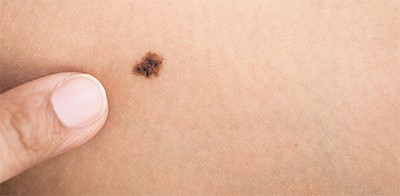Birthmarks
All shapes and sizes
|
Birthmarks come in all shapes and sizes. They can be flat or raised, with regular or irregular borders. And despite their name, not all birthmarks are always present at birth. Some develop weeks later, and though most are permanent, a few types of birthmarks fade as a child grows. Most birthmarks are harmless, but some may require treatment for cosmetic reasons or because of rapid growth. Still others may be a sign of an underlying disease. Birthmarks come in two forms. Vascular birthmarks are made up of blood vessels that haven’t formed correctly and they are usually red. Pigmented birthmarks are made of a cluster of pigment cells which cause color in skin. They can be many different colors, from tan to brown, gray to black, or even blue. No one knows what causes many types of birthmarks, but some run in families. A baby’s physician will look at the birthmark to determine if it needs any treatment or if it should be watched.
Hemangiomas
Hemangiomas are a common type of vascular birthmark, harmless growths that are the result of rapidly dividing cells of the blood vessel walls known as endothelial cells. They appear shortly after birth and grow rapidly during the first year of life. They can be different colors, depending on where they are located. Superficial hemangiomas, also known as strawberry hemangiomas due to their red color, are located in the top layer of skin. Those in the deeper layer of skin are called deep hemangiomas, and they can be blue or colorless. Most hemangiomas are limited to the skin. Children with multiple hemangiomas may have associated internal lesions involving the lungs or other internal organs. These are more serious in nature and are usually followed more closely by a pediatrician. Rapidly growing hemangiomas are usually treated with a corticosteroid, either injected into the birthmark or given by mouth, or sometimes removed by laser surgery.
Port-wine stains
About three out of every 1,000 kids will be born with a port-wine stain, a birthmark that looks like red wine was spilled on the skin. Though they often start out looking pink at birth, port-wine stains usually become darker as a child grows older. Also known as nevus flammeus, port-wine stains can be anywhere on the body but most commonly are found on the face, arms or legs. They can be any size, and usually grow in proportion with a child. They often change in texture over time. Early on, they’re smooth and flat but they may thicken and feel like pebbles under the skin during adulthood. The use of makeup has been a common treatment for port-wine stains. Laser surgery, performed on an outpatient basis, has been shown to be effective and to have minimal side effects. Several treatments are usually required, given at two month intervals. In a small number of patients, lasers can virtually erase the birthmark, lightening it from 50 to 90 percent.
Pigmented birthmarks
Pigmented birthmarks are skin markings that are present at birth. They may range from brown or black to bluish, or blue-gray in color. Mongolian spots usually are bluish and look like bruises, often appearing on the buttocks and or lower back although they sometimes appear on the trunk or arms. These spots are usually seen in people who have darker skin. Pigmented nevi, or moles, are growths on the skin that usually are flesh-colored, brown, or black and can appear anywhere on the skin, alone or in groups. Congenital nevi are moles that are present at birth and have a slightly increased risk of becoming skin cancer. Cafe-au-lait spots are light brown spots that are usually oval in shape. They usually appear at birth but might develop in the first years of a child’s life. In most cases, no treatment is needed for the birthmarks themselves. When they do require treatment, however, that treatment depends on the kind of birthmark and its related conditions.
Can be painful
There are several ways to treat a birthmark, but that decision should not be taken lightly as the treatments can be painful and don’t always work. Many will shrink or fade away with time. If your child has a birthmark that bothers them, makeup or a different hairstyle may be the answer. Corticosteroids, such as prednisone, can shrink or stop a birthmark from growing, but they can also cause weight gain. Laser therapy is often used on birthmarks like port-wine stains that are close to the surface of the skin, although it may not work on deeper marks. Surgery is usually recommended for a hemangioma that is causing a medical problem, like interfering with a child’s vision. Surgical removal of a hemangioma may leave a scar that may need to be removed or faded later on. After surgery or laser therapy, it’s important to keep the child’s fingernails short to prevent him or her from scratching the treated area and to use sunscreen each time the child is out in the sun.
Trusted by thousands of listeners every week, T. Glenn Pait, M.D., began offering expert advice as the host of UAMS’ “Here’s to Your Health” program in 1996. Dr. Pait began working at UAMS in 1994 and has been practicing medicine for over 20 years.
